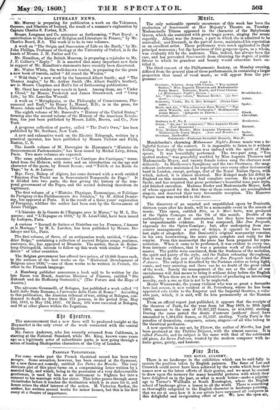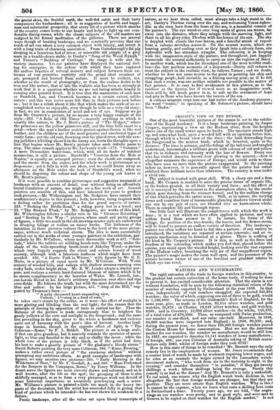fin Arto.
THE ROYAL ACADEMY.
There is no landscape in the exhibition which can be said fully to sustain the position taken by English painters. The fame of Lee and Creswick could never have been achieved by the works which bear their names now as the latest efforts of their genius, and we must be content to draw upon the memory for many beautiful pictures with which they have delighted us in the past, or what is much better—make a pilgrim- age to Turner's Wallhalla at South Kensington, where the En school of landscape gives a lesson to all the world. There is some
so thoroughly congenial to the English character in landscape paintinf, that we see at once how it is our artists have surpassed all compeele, this delightful and invigorating effort of art. We love the open oar, the genial skies, the fruitful earth, the well-fed cattle and their lusty companions the husbandman ; all is so suggestive of health and happi- ness and substantial prosperity, that every bit of a picture which smacks of the country comes home to our hearts and helps to light up our com- fortable dining-rooms, while the classic subjects of the old masters are resigned the formal ;meditation of the galleries. There are several ways though of treating landscipe, and we censtantly perceive that one touch of art can adorn a:very common object with beauty, and invest it with a long train of charming association. From Gainsliorouglisiat pig sleeping in a luxurious bed of straw, or miserable old cripple of a grey mare in a tumble-down stable, to Danby's" Song of the Wood Nymph" and Turner's "Building of Carthage," the range is wide and the variety immense. Yet our painters- have' diiplayed the national feel- ing for enterprise, in the ardour with which they have explored the endless beauties of natural scenery and subject between these ex- tremes of real primitive rusticity and the grand ideal creations of art; prompted and learned from nature. It' must be evident, too, whether as the result of photography, or from the zealous desire to be true and like nature, that of latelhe realistic aim has been so stronglyat work that it is a question whether we are not losintertistic beauty in running after painted detail, It is truc'that the mannerism of such men as Stanfield, Lee, and Creamick becomes, to a certain extent, unlike nature; and this was never more felt than in their pictures now before us ; but it has a relish about it like that which makes the style of an ac- complished writer so enjoyable, even though he tells us a very old, story; in fact, we are in Doran:lumen of mind and not of eye. Suppese we go froni'Mr. Cresvrick's picture, by no means a very happy example of his style-262. " A Relic of Old limes "—scarcely anything in which is exactly like nature, to Mr. J. Brett's picture of "The Hedger," where the primroses are the yellow min:Moses still, and the blue bells exact to a petal—where-the man's leather coat to protect against thorns is like real leather and the children are of the most genuine and unseleeted types of rustic form—yet the old ruin, frowning over the placid river, with the caw- ing jackdaws whirling about din the sunny air starts the thoughts upon a line that begins where Mr. Brett's picture takes such infinite pains to stop,. The same remark applies to Mr. Lee's only work-173. " Summer." A mere Devonshire water-lane, which, with all its faults of indolent mannerism, is still a Stanfield's "Vesuvius from. the Hole at Naples," is equally an arrange picture; even the clouds are composed, and the smoke from the crater, and the whole work is-picthresqtto as a drop-scene ; yet it falls in with our ideas, and we could dream away an afternoon on the Mole under the beck of Stanfield's wand,, when we should be disputing the colour and shape of the young oak leaves in Mr. Brett's picture.
If it were possible to combine picturesque and auggestive treatuiekiof landscape with an amount of _detail, true without being an offenattely literal translation of nature, we might see a fine work of art. Several painters are sensible of this, and have laboured for years to produce such pictures,—Mr. Witherington and Mr. Redgrave have earned their academician's degree in this pursuit; both, however, being inspired:with a feeling rather for prettiness than for the grand aspects of nature. 233. " Seeking the Bridle-Road," a riding party lost in a wood ; and
---33. "The Strayed Flock," by Mr. Redgrave, are works of this kind. Mr. Witherington follows a similar vein in his " Gleaners ,returning" and " Resting by the .Way:: "- pictures, where small and pretty groups of figures, a little too much in thnold drawing-master style are embowered in drooping foliage or recline on mossy banks. The littleness of the intention in these pictures reduces them to the level of the mere pictur- esque, without much technical charm. The idea is more successfully carried out in the works of some younger painters in the exhibition, par- ticularly by Mr. M'Callum, whose most favourable work is 417. " Soli- tude," where the rabbits are nibbling beech-nuts like Tityrus, under the abade of the wide-spreading beech-trees of Alderley Wood—a picture which very happily suggests the silent and, solemn beauty of wood scenery, although with a laborious leafuiesa which might have been avoided. 426. "A Rustic Path in Winter," with figures by Mr. G. E. Hicks, ,is "a picture of equal merit by Mr. M'Callum. With Welsh scenery of wooded hille, and valleys with shallow streams running over rooky beds, under bright skies, Mr. B. W. Leader adopts a similar pur- pose, and realizes a certain hard-featured likeness of nature which is by no means complimentary to the beauties of Wales. Mr. Linnell, jun., out-harods Herod in his father's arbitrary dominion over skies and ripe corn-fielde: He follows the truth, but with the most determined eye for blue and yellow. In his large picture, 4-51. "Atop of the Hill," sug- sated. by Thornson's lines:-
-.
" A gaily chequered heart-expanding view,
Unbour...7. I t,saing in a flood of corn," he takes one's senses by the collar, as it were—his effect of sunlight is more glaring and blinding than the real light; for the reason that the principle of forcing by opposition of tints is carried too far. Thus the distance of the picture is made outrageously blue to heighten the gaudy yellows of the corn and sunlight in the foreground ; and the same tint prevailing in the sky, gives to the whole a harshness and violence quite out of harmony with the poet's idea of harvest. Another land- scape in heroics, though in the opposite effect of light, is " The Coliseum—Rome," by F. L. Bridell. The picture is on a large scale, if that can give grandeur, lint it scarcely reminds the spectator of mien- light, so blue and fanciful is the sky and so chalky the moon; while the 'whole tone of the picture is inky black, as if the artist had done his beet to make a ghostly picture of "the gladiator's bloody circus." David Roberts painting the very same Coliseum, 286. "Rome, Evening," makes a rather sweet picture of " the enormous skeleton" without attempting any ambitions effects. As good examples of landscapes with figures, we may mention two pictures-295. " Early Morning in the Wilderness of Shur," by Mr. F. Goodall, A., and 389. "Mass Performed for the Reapers in the Campagna, Rome," by Penry Williams. In the desert scene the figures are most cleverly drawn and coloured, and as is well known, after the life on the spot; the grouping of them is also skilfully managed, so as to form a very picturesque work not devoid of some historical importance as accurately pourtraying such a scene. Mr. Williams's picture is painted &little too much in the heavy im- paste of the decorators, but the artist has succeeded fully in giving that kind of picture which he intended—he has not shown his weakness by a failure.
Poetic landscape, after all the value set upon literal transcripts of
nature, as we hear them, called, must always take a high stand in the art; Danby's Phoebus rising over the sea; and welcoming Venus Aphro- dite as she rises born from the foam, of the sea, is ti beautiful conceit of the painter's. The eye wanders over long rola-of green ciao, waves, far away into the distance, where they mingle with the morning light, and there in all /tie glory_ritles Phoebus ,with his horses-of the sun.. The sky is, dappled with pleude like rose-leaves, and a fanciful Weak of vapour from a voloano streteliea amiss it. On the, nearest waves,. which are heaving gently, and purling over as they Imeakinte a silvery.foam, site Aphrodite with her. attendant nymphs. Tha ;colouring is in keeping with the imaginative, style. of the pictere, and throughout, 'jest happily transcends the natural auffieiently to carry us into the; regions of fancy. In another work, which haelfer, its subject .on of the most terrible reali- 6qt—the lest perilous: moments. of a shipwreck—Danby still refuses to treat the subject in the realistic view, he follows Turner ; and we doubt, whether he does not conic nearer to the,point in-painting- his ship and struggling people, half invisible; in a driving stormy-Mist.; se it he felt that such a scene, was oneneither suitable nor possible to the matter of fact painter. :It is easy to ad weaknesses in tbie .pieture, _as in the rainbow or the figures, but but viewed more as an imaginative work, there will be 'felt much power in it, to MIL up the sentiment:of hope and pity in Those who have known the terrors of the sea.
A curious misprint crept into our last notice of the Academy pictures ; the word "trades," in speaking cif Afr. Solomon's picture, should have been "Hades."



























 Previous page
Previous page